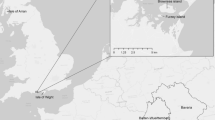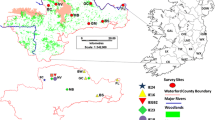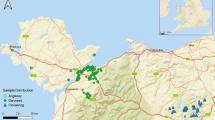Abstract
Knowledge of genetic relationships among wildlife populations is fundamental to their conservation, particularly where translocations are concerned. This study involved a survey of mitochondrial DNA variation in the Irish red squirrel population. Our main aims were: (1) to determine whether the Irish red squirrel population is distinct from that found in Britain, given known translocations that took place from Britain in the 1800’s; and (2) whether inclusion of Irish data into a reanalysis of European red squirrel data could reveal patterns of postglacial spread in Ireland. We found evidence that the current Irish red squirrel population may be a mixture of native and translocated stock, and relationships between Irish and European haplotypes supported a number of colonisation events of the island. Although only one haplotype was common to both Ireland and Britain, it is probable that the most common haplotypes in Ireland are British introductions that have since become extinct in Britain. There was a significant regional genetic structure in Ireland (P < 0.001), as well as between all Irish and British regions. Although it is likely that the red squirrel will not be fundamental in tracing the colonisation of Ireland by mammals, the data demonstrated that individual regions within Ireland, as well as the Irish population as a whole, are distinct both from the British population and from each other and, therefore, these populations should be treated as separate Management Units (MU) in conservation strategies.


Similar content being viewed by others
References
Bandelt HJ, Forster P, Röhl A (1999) Median-joining networks for inferring intraspecific phylogenies. Mol Biol Evol 16:37–48
Barratt EM, Gurnell J, Malarky G, Deaville R, Bruford MW (1999) Genetic structure of fragmented populations of red squirrel (Sciurus vulgaris) in the UK. Mol Ecol 8:S55–S63
Barrington R (1880) On the introduction of the squirrel into Ireland. Sci Proc Roy Dublin Soc 2:615–631
Brito PH (2005) The influence of Pleistocene glacial refugia on tawny owl genetic diversity and phylogeography in western Europe. Mol Ecol 14:3077–3094
Corbet GB (1961) Origin of the British insular races of small mammals and of ‘Lusitanian’ fauna. Nature 191:1037–1040
Davison A, Birks JD, Brookes RC, Messenger JE, Griffiths HI (2001) Mitochondrial phylogeography and population history of pine martens Martes martes compared with polecats Mustela putorius. Mol Ecol 10:2479–2488
Finnegan LA (2007) A genetic and morphological investigation of the factors shaping the diversity and distribution of the Eurasian red squirrel, Sciurus vulgaris. PhD thesis, University of Dublin
Fu Y-X (1997) Statistical test of neutrality of mutation against population growth, hitchhiking and background selection. Genetics 147:915–925
Hale ML, Lurz PWW, Wolff K (2004) Patterns of genetic diversity in the red squirrel (Sciurus vulgaris L.): footprints of biogeographic history and artificial introductions. Conserv Genet 5:167–179
Hamill RM, Doyle D, Duke EJ (2006) Spatial patterns of genetic diversity across European subspecies of the mountain hare, Lepus timidus L. Heredity 97:355–365
Hewitt GM (1996) Some genetic consequences of ice ages, and their role in divergence and speciation. Biol J Linn Soc 58:247–276
Hill EW, Jobling MA, Bradley DG (2000) Y-chromosome variation and Irish origins. Nature 404:351–352
Kuhner S, Tamura K, Jakobsen IB, Nei M (1998) Maximum Likelihood estimation of population growth rates based on the coalescent. Genetics 149:429–434
Kumar S, Tamura K, Jakobsen IB, Nei M (2001) MEGA 3.1: molecular evolutionary genetics analysis software. Bioinformatics 17:1244–1245
Lurz PWW, Gurnell J, Magris L (2005) Sciurus vulgaris. Mammalia 769:1–10
Martínková N, McDonald RA, Searle JB (2007) Stoats (Mustela erminea) provide evidence of natural overland colonization of Ireland. Proc Roy Soc Lond Ser B Biol Sci 274:1387–1393
Mascheretti S, Rogatcheva MB, Gündüz İ, Fredga K, Searle JB (2003) How did pygmy shrews colonize Ireland? Clues from a phylogenetic analysis of mitochondrial cytochrome b sequences. Proc Roy Soc Lond Ser B Biol Sci 270:1593–1599
McCracken E (1971) The Irish woods since Tudor times. David and Charles, Newton Abbot
Moffart CB (1923) Is the squirrel a native of Ireland? Irish Nat J 32:33–35
Moritz C (1994) Defining evolutionary significant units for conservation. Trends Ecol Evol 9:373–375
Nicholas KB, Nicholas HB Jr (1997) GENEDOC version 2.6.002: multiple sequence alignment editor and sharing utility. Available from http://www.cris.com/∼ketchup/genedoc.shtml
Nielson R, Wakely J (2001) Distinguishing migration from isolation: a Markov chain Monte Carlo approach. Genetics 158:885–896
Ó Teangana D, Reilly S, Montgomery WI, Rochford J (2000) Distribution and status of the red squirrel (Sciurus vulgaris) and grey squirrel (Sciurus carolinensis) in Ireland. Mammal Rev 30:45–56
Ogden R, Shuttleworth C, McEwing R, Cesarini S (2005) Genetic management of the red squirrel, Sciurus vulgaris: a practical approach. Conserv Genet 6:511–525
Sambrook J, Fritsch EF, Maniatis T (1989) Molecular cloning: a laboratory manual, 2nd edn. Cold Spring Harbour Laboratory Press, New York
Scharff RF (1922) Is the squirrel a native Irish species? Irish Nat 31:51–54
Scharff RF (1923) The squirrel in Ireland. Irish Nat 32:50–51, 63
Schneider S, Excoffier L (1999) Estimation of demographic parameters from the distribution of pairwise differences when the mutation rates vary among sites: application to human mitochondrial DNA. Genetics 152:1079–1089
Schneider S, Roessli D, Excoffier L (2000) ARLEQUIN ver 3.01: a software for population genetic data analysis. Genetics and Biometry Laboratory, University of Geneva, Switzerland
Sidorowicz J (1971) Problems of subspecific taxonomy of squirrel (Sciurus vulgaris L.) in Palaearctic. Zoologischer Anzeiger Leipzig 187:123–142
Seddon JM, Santucci F, Reeve NJ, Hewitt GM (2001) DNA footprints of European hedgehogs, Erinaceus europaeus and E. concolor: pleistocene refugia, postglacial expansion and colonization routes. Mol Ecol 10:2187–2198
Thompson JD, Gibson TJ, Plewniak K, Jeanmougin F, Higgins DG (1997) The Clustal_X windows interface: flexible strategies for multiple sequence alignment aided by quality analysis tools. Nucleic Acids Res 25:4876–4882
Trizio L, Crestanello B, Galbusera P, Wauters LA, Tosi G, Matthysen E, Hauffe HC (2005) Geographical distance and physical barriers shape the genetic structure of Eurasian red squirrels (Sciurus vulgaris) in the Italian Alps. Mol Ecol 14:469–481
Wingfield RTR (1995) A model of sea-levels in the Irish and Celtic seas during the end-Pleistocene to Holocene transition. In: Preece RC (ed) Island Britain: a quaternary perspective. Geological Society Special Publication 96, London, pp 209–242
Acknowledgements
We would like to thank all the people who provided samples for this study, notably Alan Poole and Geoff Hamilton. We are grateful to the Natural History Museum Dublin for allowing access to their collection and we would particularly like to thank Nigel Monaghan and Sylviane Vaucheret. Trapping during this study was carried out under license by the NPWS and we are grateful to both them and Coillte for allowing access to their sites and for assistance in the field. Invaluable laboratory guidance was provided by Victoria Dalton and Graham Little. Thanks to Marie Hale for help with DNA extraction and for positive controls from her research, and to Mark Brown for allowing access to his laboratory equipment. We also wish to thank technical staff of the Zoology Dept. for their assistance throughout. We are grateful to the referees for improvements to this manuscript. This work was funded by an Irish Research Council for Science Engineering and Technology Postgraduate Scholarship under the Embark Initiative.
Author information
Authors and Affiliations
Corresponding author
Rights and permissions
About this article
Cite this article
Finnegan, L.A., Edwards, C.J. & Rochford, J.M. Origin of, and conservation units in, the Irish red squirrel (Sciurus vulgaris) population. Conserv Genet 9, 1099–1109 (2008). https://doi.org/10.1007/s10592-007-9419-7
Received:
Accepted:
Published:
Issue Date:
DOI: https://doi.org/10.1007/s10592-007-9419-7




